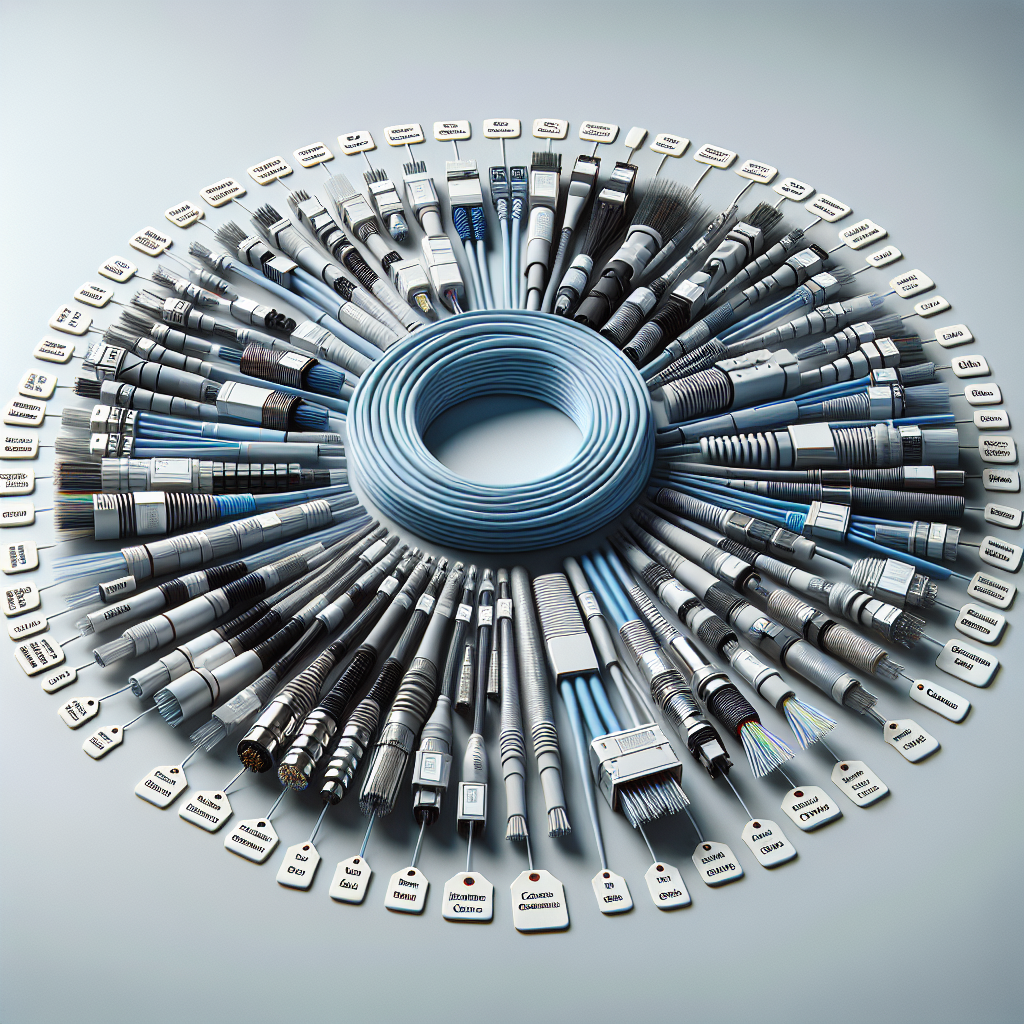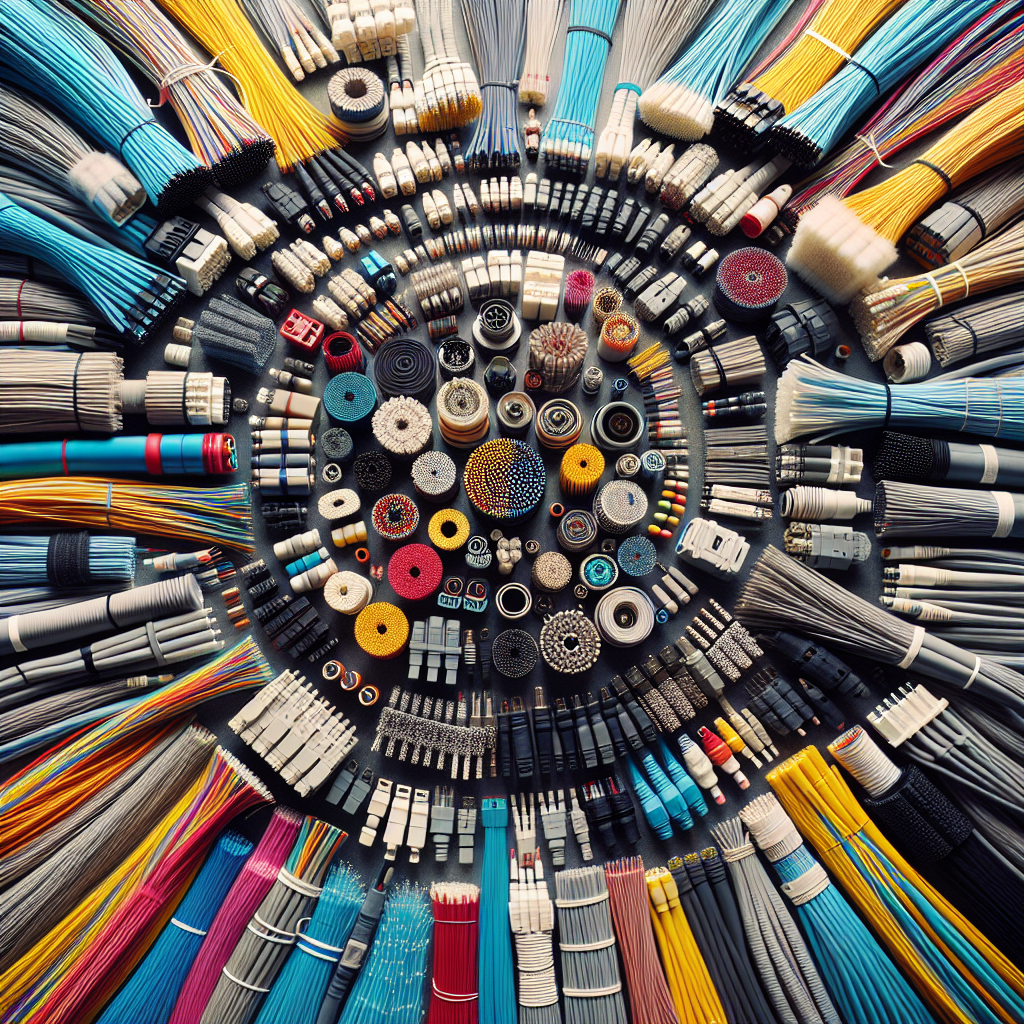Fiber optic network cables are the backbone of modern telecommunications, enabling high-speed data transmission over vast distances. The diversity of fiber optic cable types is a fascinating aspect of this technology, offering a wide range of options to suit different needs and applications. From single-mode cables for long-distance communication to multi-mode cables for shorter distances, each type has its own unique characteristics and advantages. This article will explore the various fiber optic network cable types available, shedding light on the intricacies of this essential infrastructure that powers our connected world.
Understanding Fiber Optic Cables

Fiber optic cables are advanced communication cables that utilize thin strands of glass or plastic to transmit data in the form of light signals. These cables are designed for long-distance, high-performance data networking and are widely used in telecommunications and computer networking systems.
- Definition of Fiber Optic Cables
- Fiber optic cables are composed of a core, cladding, and buffer coating. The core is where the light signals travel, surrounded by the cladding that reflects the light back into the core. The buffer coating provides protection to the delicate fibers.
-
These cables can transmit data over long distances with minimal signal loss, making them ideal for high-speed internet connections and other data-intensive applications.
-
How Fiber Optic Cables Transmit Data
- Fiber optic cables transmit data through the process of total internal reflection, where light signals bounce off the walls of the core due to differences in refractive indices between the core and cladding.
-
The light signals travel through the core without significant loss, allowing for faster and more reliable data transmission compared to traditional copper cables.
-
Advantages of Fiber Optic Cables
- Fiber optic cables offer higher bandwidth and faster data transmission speeds than copper cables, making them suitable for applications that require high data throughput.
- These cables are immune to electromagnetic interference and radiofrequency interference, ensuring secure and reliable data transmission.
- Fiber optic cables are also lightweight, durable, and less prone to damage from environmental factors such as moisture and temperature fluctuations.
Single-Mode Fiber Optic Cables
Understanding Fiber Optic Cables
Characteristics of Single-Mode Fiber Optic Cables:
Single-mode fiber optic cables have a small core size, typically around 9 microns in diameter, allowing only one mode of light to pass through. This results in a higher bandwidth and longer transmission distances compared to multi-mode fiber cables. The core is made of a highly purified glass, which reduces modal dispersion and ensures that the light signals travel straight down the core without bouncing off the edges.
Single-mode fiber optic cables are designed for long-distance communication networks, such as telecommunications and cable television. They are ideal for transmitting data over significant distances without losing signal strength or clarity. Due to their narrower core size, single-mode cables require precision alignment when connecting components to minimize signal loss.
Applications of Single-Mode Fiber Optic Cables:
Single-mode fiber optic cables are commonly used in high-speed data transmission applications, including long-distance telecommunication networks, internet backbone infrastructure, and connections between data centers. They are also utilized in cable television networks to deliver high-definition video and audio signals with minimal interference.
In the medical field, single-mode fiber cables are employed in endoscopy procedures to transmit high-resolution images from inside the body to external monitors. Additionally, single-mode fibers play a crucial role in military and aerospace applications, where secure and reliable data transmission is essential for communication and surveillance systems.
Benefits of Single-Mode Fiber Optic Cables:
The primary advantage of single-mode fiber optic cables is their ability to transmit data over long distances with minimal signal loss. This makes them ideal for applications where maintaining signal integrity over hundreds of kilometers is crucial. Single-mode fibers also offer higher bandwidth capacity, allowing for faster data transfer rates and increased network efficiency.
Another key benefit of single-mode fiber cables is their immunity to electromagnetic interference, making them highly reliable in environments with high electrical noise. Additionally, single-mode fibers have a smaller core size, resulting in lower attenuation rates and improved signal quality over extended distances.
Multi-Mode Fiber Optic Cables
Multi-mode fiber optic cables are a type of optical fiber that allows multiple modes of light to propagate. These cables have a larger core size compared to single-mode fibers, enabling them to carry multiple light rays simultaneously.
- Characteristics of Multi-Mode Fiber Optic Cables
- Multi-mode fiber optic cables typically have a core size of 50 to 62.5 microns, which allows for easy coupling of LED light sources.
- These cables are designed to transmit data over short to medium distances, making them ideal for use in buildings, data centers, and LAN networks.
-
Due to their larger core size, multi-mode fiber optic cables have higher dispersion and attenuation compared to single-mode fibers.
-
Applications of Multi-Mode Fiber Optic Cables
- Multi-mode fiber optic cables are commonly used in applications where high bandwidth is required over short distances, such as in local area networks (LANs) and campus networks.
- They are also used in data centers for connecting servers and storage area networks (SANs) due to their ability to support high data transfer rates.
-
Additionally, multi-mode fiber optic cables are often used for audio and video applications, including broadcasting and live event production.
-
Benefits of Multi-Mode Fiber Optic Cables
- One of the key advantages of multi-mode fiber optic cables is their cost-effectiveness, making them a popular choice for short-distance communication networks.
- These cables are also easier to install and terminate compared to single-mode fibers, reducing deployment time and labor costs.
- Multi-mode fiber optic cables support various transmission technologies, including Ethernet, InfiniBand, and Fibre Channel, providing flexibility for different network requirements.
Comparing Fiber Optic Cable Types
When comparing fiber optic cable types, it is crucial to consider various factors that can impact their performance and suitability for specific network requirements. Several key aspects to examine include speed and distance considerations, cost analysis of single-mode vs. multi-mode fiber optic cables, and the suitability of each type for different network environments.
Speed and Distance Considerations
Fiber optic cables come in different types, each offering varying speeds and distances for data transmission.
- Single-mode fiber optic cables are designed for long-distance communication and high-speed data transmission.
- Multi-mode fiber optic cables are more suitable for shorter distances and are commonly used in local area networks (LANs).
- The speed and distance capabilities of fiber optic cables are determined by factors such as the core diameter and the light source used for transmission.
Cost Analysis of Single-Mode vs. Multi-Mode Fiber Optic Cables
Cost is a significant consideration when choosing between single-mode and multi-mode fiber optic cables.
- Single-mode fiber optic cables generally have a higher initial cost due to their advanced technology and longer transmission distances.
- Multi-mode fiber optic cables are more cost-effective for shorter distances but may require more frequent upgrades for high-speed applications.
- The total cost of ownership should be evaluated, taking into account installation, maintenance, and future scalability.
Suitability for Different Network Environments
The choice between single-mode and multi-mode fiber optic cables also depends on the specific network environment and requirements.
- Single-mode fiber optic cables are ideal for long-haul telecommunications, backbone networks, and data centers where high bandwidth and reliability are essential.
- Multi-mode fiber optic cables are commonly used in shorter reach applications such as campus networks, enterprise LANs, and audiovisual systems.
- Understanding the environmental factors, performance needs, and budget constraints of the network will help determine the most suitable fiber optic cable type.
Factors Influencing Cable Selection
When selecting fiber optic network cables, various factors come into play to ensure optimal performance and efficiency. These factors influence the choice of cable type based on the specific requirements of the network infrastructure.
Bandwidth Requirements
-
Bandwidth Demands: The amount of data to be transmitted over the network dictates the type of fiber optic cable needed. Higher bandwidth requirements necessitate cables with greater capacity to support data transfer at high speeds.
-
Single-mode vs. Multi-mode: Single-mode fiber cables are suitable for long-distance transmissions and high bandwidth applications, while multi-mode fibers are more cost-effective for shorter distances and lower bandwidth needs.
Installation Environment
-
Indoor vs. Outdoor: The installation environment plays a crucial role in selecting the appropriate fiber optic cable. Outdoor cables are designed to withstand harsh weather conditions and UV exposure, while indoor cables are optimized for controlled indoor environments.
-
Aerial, Underground, or Buried: Depending on whether the cables will be installed aerially, underground, or buried, different cable types are chosen to ensure durability and longevity in specific installation scenarios.
Future Scalability Needs
-
Flexibility for Expansion: Considering future scalability needs is essential when selecting fiber optic cables. Choosing cables that can accommodate future upgrades and expansions without requiring significant infrastructure changes is crucial for long-term network planning.
-
Compatibility with Advanced Technologies: Selecting fiber optic cables that are compatible with emerging technologies and higher transmission speeds ensures that the network infrastructure can adapt to technological advancements without the need for frequent cable replacements.
By carefully evaluating these factors influencing cable selection, network administrators can choose the most suitable fiber optic cable types to meet the unique requirements of their network infrastructure.

Fiber Optic Cable Connectors and Interfaces
Fiber optic cable connectors play a crucial role in ensuring efficient data transmission within a network. These connectors come in various types, each designed for specific applications and environments. Understanding the different types of fiber optic connectors is essential for ensuring compatibility and optimal performance.
- Types of Fiber Optic Connectors
- LC Connector: Small form factor connector commonly used in data centers and telecommunication networks due to its high performance and reliability.
- SC Connector: Square connector widely used in enterprise networks for its simple push-pull mechanism and durability.
- ST Connector: Bayonet-style connector commonly found in older networks and industrial applications.
-
MTP/MPO Connector: Multi-fiber connector used for high-density applications such as backbone cabling and data centers.
-
Compatibility with Different Cable Types
- Different fiber optic connectors are designed to be compatible with specific cable types, such as single-mode or multi-mode fibers.
-
It is crucial to ensure that the connector type matches the cable type to avoid signal loss or compatibility issues.
-
Importance of Proper Cleaning and Maintenance
- Regular cleaning and maintenance of fiber optic connectors are essential to prevent contamination and ensure optimal performance.
- Contaminants such as dust, oil, and dirt can degrade signal quality and lead to network issues.
- Using proper cleaning tools and techniques, such as lint-free wipes and alcohol-based cleaners, is critical for maintaining connector integrity.
Common Fiber Optic Connectors
- LC Connectors
- LC connectors, standing for Lucent Connector, are small form-factor connectors commonly used in high-density connections.
- They feature a 1.25mm ceramic ferrule, making them ideal for applications requiring precise alignment.
-
LC connectors are favored for their low insertion loss and high return loss properties, ensuring efficient data transmission.
-
SC Connectors
- SC connectors, or Subscriber Connectors, are widely used for data communication applications.
- They feature a push-pull coupling mechanism for easy and secure connections.
-
SC connectors are known for their excellent performance in single-mode fiber optic networks, providing low reflectance and high precision.
-
ST Connectors
- ST connectors, or Straight Tip connectors, are one of the oldest types of fiber optic connectors.
- They utilize a bayonet-style coupling mechanism for quick and reliable connections.

- ST connectors are commonly used in multimode networks and are known for their durability and robustness in various environmental conditions.
Emerging Trends in Fiber Optic Network Technology
In recent years, the field of fiber optic network technology has witnessed significant advancements and innovations, leading to a diverse array of cable types tailored to specific needs and applications. These emerging trends highlight the industry’s continuous quest for faster, more reliable, and efficient communication networks.
Introduction to Fiber Optic Network Innovations
Fiber optic network innovations encompass a wide range of developments aimed at enhancing data transmission capabilities and improving network performance. One notable innovation is the introduction of bend-insensitive fibers, which allow for more flexible installations in tight spaces without compromising signal quality. Additionally, the integration of multicore fibers has enabled higher data throughput by transmitting multiple signals simultaneously through separate cores within a single cable.
Impact of Technological Advancements on Cable Types
Technological advancements have played a crucial role in shaping the evolution of fiber optic network cable types. The development of single-mode and multimode fibers has paved the way for tailored solutions catering to different transmission distances and bandwidth requirements. Moreover, the deployment of advanced materials such as carbon nanotubes and photonic crystals has led to the creation of specialty fibers capable of supporting specific applications like sensing and quantum communication.
Future Prospects for Fiber Optic Network Evolution
Looking ahead, the future of fiber optic network technology appears promising, with ongoing research focusing on enhancing cable durability, increasing data transmission speeds, and reducing signal loss. Innovations such as hollow-core fibers, which guide light through air or a vacuum instead of traditional glass, hold the potential to revolutionize long-distance communication by minimizing signal attenuation and enabling faster transmission rates. Furthermore, the integration of artificial intelligence and machine learning algorithms into network management systems is expected to streamline operations, optimize performance, and enhance overall network reliability.
Fiber Optic Network Cable Types in Next-Generation Networks
In next-generation networks, the selection of fiber optic network cable types plays a crucial role in ensuring efficient data transmission and connectivity. Various types of fiber optic cables are utilized to meet the diverse needs of modern communication networks. These cable types are designed with specific characteristics to optimize performance and reliability in different environments and applications.
Single-Mode Fiber Optic Cables
– Single-mode fiber optic cables are designed to carry a single ray of light, allowing for high-speed data transmission over long distances.
– These cables have a small core size, typically around 9 microns, which reduces light dispersion and enables signal transmission with minimal loss.
– Single-mode fiber optic cables are ideal for long-haul communication networks, inter-city connections, and telecommunication backbones where high bandwidth and low latency are essential.
Multi-Mode Fiber Optic Cables
– Multi-mode fiber optic cables are designed to carry multiple light rays simultaneously, allowing for high data transmission rates over shorter distances.
– These cables have a larger core size, typically around 50 to 62.5 microns, which enables easier coupling of light sources and receivers.
– Multi-mode fiber optic cables are commonly used in data centers, enterprise networks, and local area networks where high-speed connectivity over limited distances is required.
Plenum vs. Riser Fiber Optic Cables
– In next-generation networks, the choice between plenum and riser fiber optic cables is essential to ensure compliance with building codes and safety regulations.
– Plenum cables are designed for use in plenum spaces, such as air ducts, where fire safety requirements are strict. These cables have a special jacket that releases minimal smoke and toxic fumes when exposed to fire.
– Riser cables, on the other hand, are suitable for vertical runs between floors in buildings. They have a fire-resistant jacket but may not meet the stringent requirements for plenum spaces.
Armored Fiber Optic Cables
– Armored fiber optic cables are reinforced with a protective layer, typically made of steel or aluminum, to enhance durability and resistance to environmental factors.
– These cables are used in harsh environments where mechanical protection is crucial, such as outdoor installations, industrial settings, and undersea cables.
– Armored fiber optic cables offer increased tensile strength and crush resistance, ensuring reliable performance in challenging conditions.
By understanding the characteristics and applications of different fiber optic network cable types, network operators and service providers can effectively deploy the most suitable cables to support the growing demands of next-generation networks.
FAQs – Exploring the Diversity of Fiber Optic Network Cable Types
What are the different types of fiber optic network cables available?
There are several types of fiber optic network cables available, including single-mode fiber optic cables, which are designed for long-distance transmissions, and multi-mode fiber optic cables, which are more suitable for short distances with high-bandwidth applications. There are also armored fiber optic cables, which provide extra protection against physical damage, and indoor/outdoor fiber optic cables, which are versatile and can be used for both indoor and outdoor installations.
How do single-mode and multi-mode fiber optic cables differ?
Single-mode fiber optic cables have a smaller core and are designed for long-distance transmissions over 10 kilometers, making them ideal for telecommunications and data centers. On the other hand, multi-mode fiber optic cables have a larger core that allows multiple modes of light to travel through it simultaneously, making them more suitable for shorter distances of up to 500 meters, such as local area networks (LANs) and video surveillance systems.
What are armored fiber optic cables used for?
Armored fiber optic cables are designed to provide extra protection against physical damage, such as crushing, bending, and rodent attacks. They are commonly used in harsh environments, including industrial settings, outdoor installations, and areas with heavy foot traffic. Armored fiber optic cables are also useful in situations where the cable may be exposed to extreme temperatures or other environmental hazards.
Can indoor/outdoor fiber optic cables be used for both indoor and outdoor installations?
Yes, indoor/outdoor fiber optic cables are versatile and can be used for both indoor and outdoor installations. These cables are designed to withstand a wide range of environmental conditions, including moisture, UV radiation, and temperature fluctuations. Indoor/outdoor fiber optic cables are often used in applications where the cable needs to transition between indoor and outdoor environments, such as connecting a building’s internal network to an external internet connection.


